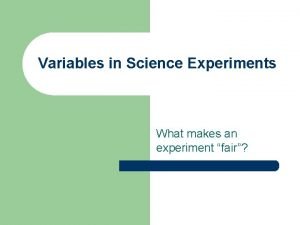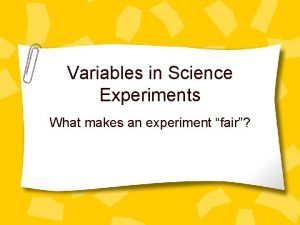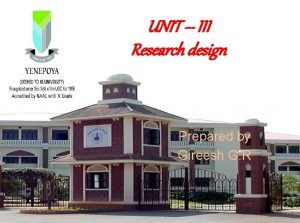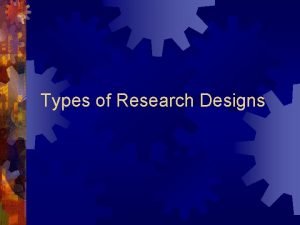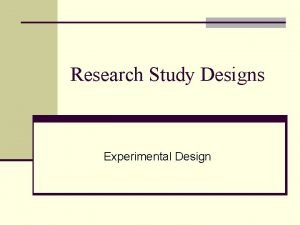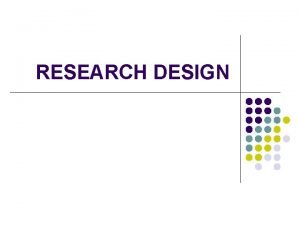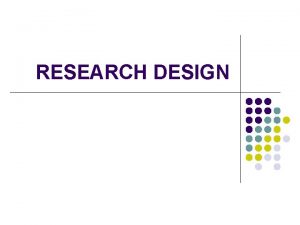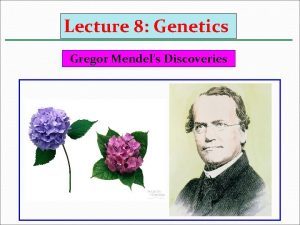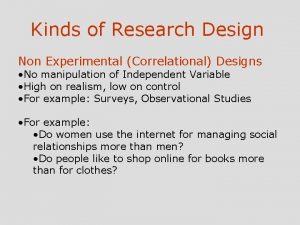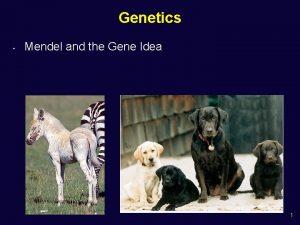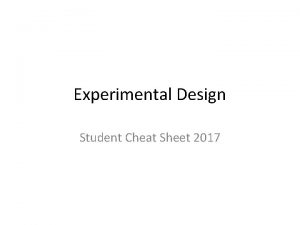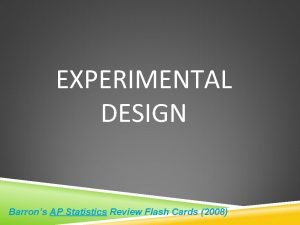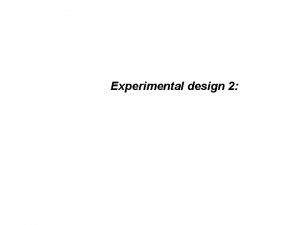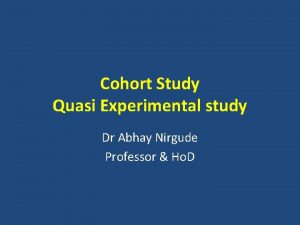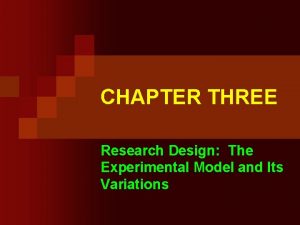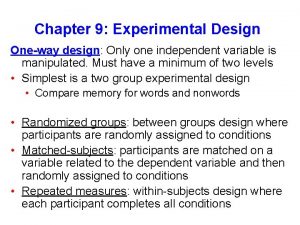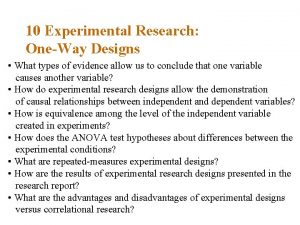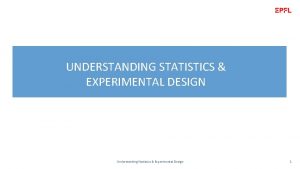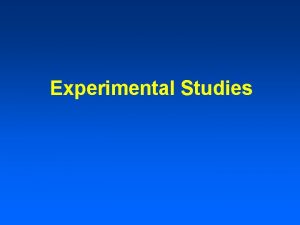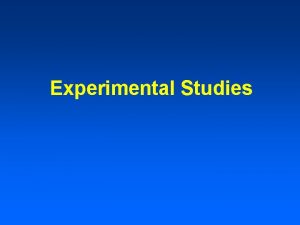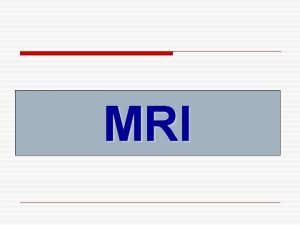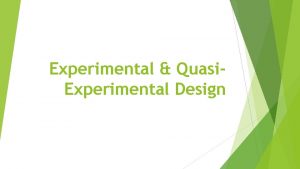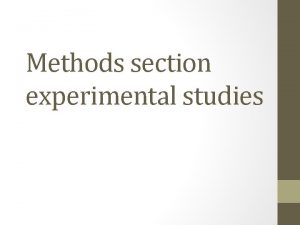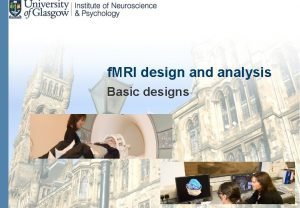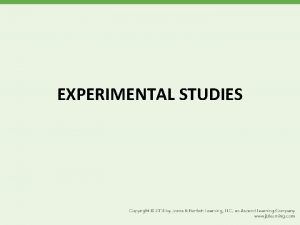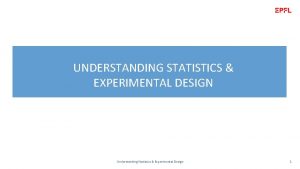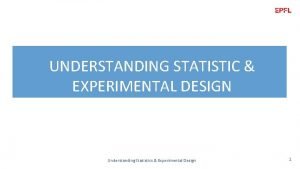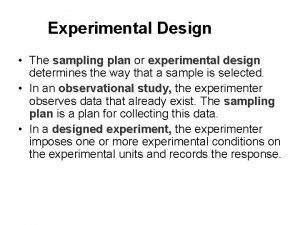Experimental design of f MRI studies Sandra Iglesias



































- Slides: 35

Experimental design of f. MRI studies Sandra Iglesias Translational Neuromodeling Unit University of Zurich & ETH Zurich With many thanks for slides & images to: Klaas Enno Stephan, FIL Methods group, Christian Ruff SPM Course 2012

Overview of SPM Image time-series Realignment Kernel Smoothing Design matrix Statistical parametric map (SPM) General linear model Statistical inference Normalisation Gaussian field theory p <0. 05 Template Parameter estimates 2

Overview of SPM Research question: Which neuronal structures support face recognition? Hypothesis: The fusiform gyrus is implicated in face recognition Design matrix Statistical parametric map (SPM) General linear model Statistical inference Experimental design Gaussian field theory p <0. 05 Parameter estimates 3

Overview • Categorical designs Subtraction - Pure insertion, evoked / differential responses Conjunction - Testing multiple hypotheses • Parametric designs Linear Nonlinear - Adaptation, cognitive dimensions - Polynomial expansions, neurometric functions • Factorial designs Categorical Parametric - Interactions and pure insertion - Linear and nonlinear interactions - Psychophysiological Interactions 4

Cognitive subtraction • Aim: – Neuronal structures underlying a single process P? • Procedure: – Contrast: [Task with P] – [control task without P ] = P the critical assumption of „pure insertion“ • Example: [Task with P] – [task without P ] = P – = 5

Cognitive subtraction • Aim: – Neuronal structures underlying a single process P? • Procedure: – Contrast: [Task with P] – [control task without P ] = P the critical assumption of „pure insertion“ • Example: [Task with P] – [task without P ] = P – = 6

Cognitive subtraction: Baseline problems Which neuronal structures support face recognition ? • „Distant“ stimuli - Several components differ! • „Related“ stimuli - P implicit in control condition? „Queen!“ „Aunt Jenny? “ • Same stimuli, different task Name Person! Name Gender! Interaction of task and stimuli (i. e. do task differences depend on stimuli chosen)? 7

A categorical analysis Experimental design Face viewing Object viewing F O F - O = Face recognition O - F = Object recognition …under assumption of pure insertion Kanwisher N et al. J. Neurosci. 1997; 8

Categorical design 9

Overview • Categorical designs Subtraction - Pure insertion, evoked / differential responses Conjunction - Testing multiple hypotheses • Parametric designs Linear Nonlinear - Adaptation, cognitive dimensions - Polynomial expansions, neurometric functions • Factorial designs Categorical Parametric - Interactions and pure insertion - Linear and nonlinear interactions - Psychophysiological Interactions 10

Conjunctions • One way to minimize the baseline/pure insertion problem is to isolate the same process by two or more separate comparisons, and inspect the resulting simple effects for commonalities • A test for such activation common to several independent contrasts is called “conjunction” • Conjunctions can be conducted across a whole variety of different contexts: • tasks • stimuli • senses (vision, audition) • etc. • Note: the contrasts entering a conjunction must be orthogonal (this is ensured automatically by SPM) 11

Conjunctions Example: Which neural structures support object recognition, independent of task (naming vs. viewing)? Task (1/2) Viewing Naming Objects Colours Stimuli (A/B) A 2 A 1 B 1 B 2 Visual Processing Object Recognition Phonological Retrieval V R P 12

Conjunctions Objects Colours Stimuli (A/B) Viewing Task (1/2) Naming A 1 A 2 Visual Processing V Visual Processing Phonological Retrieval B 1 B 2 Visual Processing V Object Recognition R Visual Processing Phonological Retrieval Object Recognition Which neural structures support object recognition? (Object - Colour viewing) [B 1 - A 1] & (Object - Colour naming) [B 2 – A 2] [ V, R - V ] & [ P, V, R - P, V ] = R & R = R Price et al. 1997 V P R Common object recognition response (R) A 1 B 1 A 2 B 2 13

Conjunctions 14

Two types of conjunctions “Which voxels show effects of similar direction (but not necessarily individual significance) across contrasts? ” Null hypothesis: No contrast is significant: k = 0 does not correspond to a logical AND ! B 1 -B 2 • Test of global null hypothesis: Significant set of consistent effects p(A 1 -A 2) < + + p(B 1 -B 2) < • Test of conjunction null hypothesis: Set of consistently significant effects “Which voxels show, for each specified contrast, significant effects? ” A 1 -A 2 Null hypothesis: Not all contrasts are significant: k < n Friston et al. (2005). Neuroimage, 25: 661 -667. corresponds to a logical AND Nichols et al. (2005 ). Neuroimage, 25: 653 -660. ( 15

F-test vs. conjunction based on global null grey area: bivariate t-distriution under global null hypothesis Friston et al. 2005, Neuroimage, 25: 661 -667. 16

Overview • Categorical designs Subtraction - Pure insertion, evoked / differential responses Conjunction - Testing multiple hypotheses • Parametric designs Linear Nonlinear - Adaptation, cognitive dimensions - Polynomial expansions, neurometric functions • Factorial designs Categorical Parametric - Interactions and pure insertion - Linear and nonlinear interactions - Psychophysiological Interactions 17

Parametric designs • Parametric designs approach the baseline problem by: – Varying the stimulus-parameter of interest on a continuum, in multiple (n>2) steps. . . –. . . and relating measured BOLD signal to this parameter • Possible tests for such relations are manifold: • Linear • Nonlinear: Quadratic/cubic/etc. (polynomial expansion) • Model-based (e. g. predictions from learning models) 18

“User-specified” parametric modulation of regressors Polynomial expansion & orthogonalisation Büchel et al. 1998, Neuro. Image 8: 140 -148 19

Investigating neurometric functions (= relation between a stimulus property and the neuronal response) Pain threshold: 410 m. J P 0 P 1 P 2 P 3 P 4 Büchel et al. 2002, J. Neurosci. 22: 970 -976 Stimulus awareness Stimulus intensity Pain intensity P 0 -P 4: Variation of intensity of a laser stimulus applied to the right hand (0, 300, 400, 500, and 600 m. J) 20

Neurometric functions Stimulus intensity Stimulus presence Pain intensity 21 Büchel et al. 2002, J. Neurosci. 22: 970 -976

Model-based regressors • general idea: generate predictions from a computational model, e. g. of learning or decision-making • Commonly used models: – Rescorla-Wagner learning model – temporal difference (TD) learning model – Bayesian learners • use these predictions to define regressors • include these regressors in a GLM and test for significant correlations with voxel-wise BOLD responses 22

Model-based f. MRI analysis Gläscher & O‘Doherty 2010, WIREs Cogn. Sci. 23

Model-based f. MRI analysis Gläscher & O‘Doherty 2010, WIREs Cogn. Sci. 24

Overview • Categorical designs Subtraction - Pure insertion, evoked / differential responses Conjunction - Testing multiple hypotheses • Parametric designs Linear Nonlinear - Adaptation, cognitive dimensions - Polynomial expansions, neurometric functions • Factorial designs Categorical Parametric - Interactions and pure insertion - Linear and nonlinear interactions - Psychophysiological Interactions 25

Main effects and interactions Objects Colours Stimuli (A/B) Task (1/2) Viewing Naming A 1 A 2 B 1 B 2 • Main effect of task: (A 1 + B 1) – (A 2 + B 2) • Main effect of stimuli: (A 1 + A 2) – (B 1 + B 2) • Interaction of task and stimuli: Can show a failure of pure insertion (A 1 – B 1) – (A 2 – B 2)

Factorial design Objects Colours Stimuli (A/B) Task (1/2) A 1 B 1 A 2 B 2 Viewing Naming A 1 A 2 B 1 B 2 Main effect of task: (A 1 + B 1) – (A 2 + B 2) 27

Factorial design Objects Colours Stimuli (A/B) Task (1/2) A 1 B 1 A 2 B 2 Viewing Naming A 1 A 2 B 1 B 2 Main effect of stimuli: (A 1 + A 2) – (B 1 + B 2) 28

Factorial design Objects Colours Stimuli (A/B) Task (1/2) A 1 B 1 A 2 B 2 Viewing Naming A 1 A 2 B 1 B 2 Interaction of task and stimuli: (A 1 – B 1) – (A 2 – B 2) 29

Main effects and interactions Objects Colours Stimuli (A/B) Task (1/2) Viewing Naming A 1 A 2 B 1 B 2 • Main effect of task: (A 1 + B 1) – (A 2 + B 2) • Main effect of stimuli: (A 1 + A 2) – (B 1 + B 2) • Interaction of task and stimuli: Can show a failure of pure insertion (A 1 – B 1) – (A 2 – B 2) Is the inferotemporal region implicated in phonological retrieval during object naming? Colours Objects Viewing interaction effect (Stimuli x Task) Colours Objects Naming 30

Example: evidence for inequality-aversion Tricomi et al. 2010, Nature 31

Psycho-physiological interactions (PPI) Task factor Stim 1 Task B main effect of task TA/S 1 TB/S 1 main effect of stim. type interaction Stim 2 Stimulus factor Task A GLM of a 2 x 2 factorial design: TA/S 2 TB/S 2 We can replace one main effect in the GLM by the time series of an area that shows this main effect. E. g. let's replace the main effect of stimulus type by the time series of area V 1: main effect of task V 1 time series main effect of stim. type psychophysiological interaction 32

PPI example: attentional modulation of V 1→V 5 activity SPM{Z} Attention V 1 V 5 time V 1 x Att. V 5 Friston et al. 1997, Neuro. Image 6: 218 -229 Büchel & Friston 1997, Cereb. Cortex 7: 768 -778 V 5 activity = attention no attention V 1 activity 33

PPI: interpretation Two possible interpretations of the PPI term: attention V 1 V 5 Modulation of V 1 V 5 by attention V 1 V 5 Modulation of the impact of attention on 34 V 5 by V 1.

Thank you 35
 Non experimental design vs experimental
Non experimental design vs experimental Experimental vs non experimental
Experimental vs non experimental Experimental vs non experimental
Experimental vs non experimental Experimental vs non experimental research
Experimental vs non experimental research Experimental vs non experimental
Experimental vs non experimental Types of experimental studies
Types of experimental studies Paradigm shift from women studies to gender studies
Paradigm shift from women studies to gender studies What is a dependent variable in science
What is a dependent variable in science Experimental design independent and dependent variables
Experimental design independent and dependent variables Characteristics of experimental research design
Characteristics of experimental research design Quasi experimental design example
Quasi experimental design example Experimental study design
Experimental study design Non experimental research topics
Non experimental research topics Non-experimental design definition
Non-experimental design definition Disadvantage of quasi experiment
Disadvantage of quasi experiment 11 principles of design
11 principles of design Mendel's experimental design
Mendel's experimental design Mendel's experimental design
Mendel's experimental design Mendel's experimental design
Mendel's experimental design Experimental research design
Experimental research design Mendel
Mendel Ethical issues of experimental research
Ethical issues of experimental research Experimental research
Experimental research Matched pairs experiment
Matched pairs experiment Anova excel
Anova excel Experimental design cheat sheet
Experimental design cheat sheet A bank wishes to survey its customers
A bank wishes to survey its customers Solomon four group design
Solomon four group design Retrospective cohort study vs case control
Retrospective cohort study vs case control Classic experimental design
Classic experimental design One-way experimental design
One-way experimental design Mendel's experimental design
Mendel's experimental design Bias in experimental design
Bias in experimental design One-way design
One-way design Statistics
Statistics Experimental design assistant
Experimental design assistant







